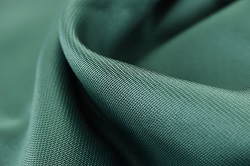Major Faults in Dyed and Printed Fabrics

The causes of these faults can be classified into four categories
- Poor quality of dyeing processes
- Poor quality of printing processes
- Shortcomings in finishing processes
- Poor quality of raw materials
Following is the list of the major problems or faults commonly found in printed or dyed fabrics
- Horizontal lines
- Shade variation
- Barre
- Dirt/stains
- Uneven dyeing
- Drop stitches
- Misprinting
- Crease marks
- Flushing / Wicking
- Bleeding
- Misfits
- Stick-ins
- Double printing
- Scrimps
Faults Description
Horizontal lines
Horizontal lines on fabric are usually caused by a fault in the weaving process, such as when the warp yarns were not properly aligned.
Shade variation
This is when one side of the fabric is lighter than the other and can be caused by a variety of things, such as improper dyeing or printing, or variations in heat during processing.
Dirt or Stains
Dirt/stains on fabric are usually caused by contact with soil, food, or other materials that leave an unwanted mark on it.
Uneven Dyeing
Uneven dyeing can be due to a variety of factors including uneven application of colorant; uneven absorption of colorant; or variation in temperature during processing.
Drop Stitches
Drop stitches are a type of fault that happens when the thread is not secured correctly. This can happen at any point in the process, and it can be difficult to identify the problem before it has been completed.
Misprinting
Misprinting is when fabric is printed with an incorrect pattern or color. It typically happens because of a printer error or human error during printing.
Crease Marks
Crease Marks are caused by folding fabric that has been improperly pressed or folded. They are often considered as a fault because they will often show through after the garment has been sewn together and may look unsightly on the finished product.
Barre
Barre is a type of fault that happens when there is too much tension on one side of a woven fabric and not enough on the other side. Sometime this problem also occurs due to blend variation in yarn used in fabric weaving.
Flushing or Wicking
This is due to low viscosity of print paste. The ink or dye in the paste does not stay at the bottom of the screen but instead moves up and down.
Colour Bleeding
When a fabric has two different colours, one colour will bleed into another causing a new colour to be formed. This can happen due to many reasons such as low viscosity of print paste, overprinting and ink spread.
Misfits
These are small dots that appear on the fabric when there is an irregularity in printing process such as with overprinting, ink spread etc.
Stick-ins and double printing
Stick-ins are small pieces of fabric that have been left behind by an operator who was cutting or sewing the material.
Double printing
Double printing is when a pattern has been printed on both sides of a piece of fabric without being flipped over, which will create an upside down pattern on one side and an inverted one on the other side.
Finally, look for scrimps
These are small pieces of thread that have not been completely cut off after sewing and can be found anywhere on the fabric.
